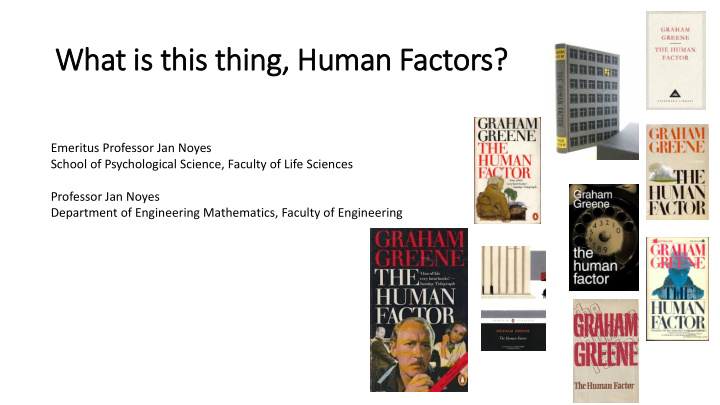



What is this thing, g, Human Factors? Emeritus Professor Jan Noyes School of Psychological Science, Faculty of Life Sciences Professor Jan Noyes Department of Engineering Mathematics, Faculty of Engineering
Snapshot: Lessons Learned 1. Importance of expectations – pen-based input work with Hewlett- Packard. 2. Language is a hurdle as is implicit knowledge – familiarisation work with British Airways. 3. Work with GCHQ/MoD – language and relevancy markers (so, well, but). 4. Information overload – human as the bottleneck – warning and diagnostic system/energy management system with GE Aviation/NASA. 5. Hybrid semi-autonomous systems (Thales) – autonomy will not happen in the near future.
1. . Expectations and In Intuitiveness When using technology, we base our expectations on what we know about human to human communications. This can create problems. Better off with counter-intuitive designs? In fact, surrounded by counter-intuitive designs. E.g. keyboards
2. . La Language Example: In Interv rview with Jeremy Ir Irons, Actor So how did he do it, I asked him. How, when there no discernible physical difference between the twins, did he make their distinct personalities so palpable. “ It was simple ”, he said, with a sly smile. “ With Elliot, the aggressive twin, I acted from here .” And he pointed to his forehead. “ And with Beverly, the shy wimpy one, I acted from here .” And he pointed to his throat. “ You see? ”
The Key • Design from the point of view of the human not from the ‘external characteristics ’ – human factors psychology/ergonomics involvement. • Most design does not do this. • We are surrounded by poor design. • Computers, doors, chairs, everyday products/objects … … to advanced and emerging technologies and systems.
Challenge for the Future To locate the optimal level of human-system co-operation. In information-rich systems, how can we facilitate human-robot interactions given the ‘bottle - necks’ in the interaction? What is the appropriate degree of automation/autonomy? How do we manage issues of agency, control, trust, complacency, ethics, groups?
Recommend
More recommend